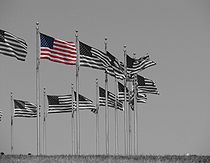
Selective color
Encyclopedia

Post-processing
Post-processing may refer to:* Differential GPS post-processing* Video post-processing, methods used in video processing and 3D graphics* Finite element model data post-processing...
technique where most of a photo is converted to black and white, but some parts are left in color. This is usually achieved by using layers and masks in photo editing software (Photoshop, SilverFast
SilverFast
SilverFast is software for scanning and image processing, including photos, documents and slides, developed by LaserSoft Imaging.- History :...
, Adobe Fireworks or The GIMP for example).
A common application for selective color is portraiture
Portrait photography
Portrait photography or portraiture is the capture by means of photography of the likeness of a person or a small group of people , in which the face and expression is predominant. The objective is to display the likeness, personality, and even the mood of the subject...
, to keep the eyes and sometimes the lips in color, against an otherwise black-and-white photograph. Small regions of color in an otherwise monochrome
Monochrome
Monochrome describes paintings, drawings, design, or photographs in one color or shades of one color. A monochromatic object or image has colors in shades of limited colors or hues. Images using only shades of grey are called grayscale or black-and-white...
image immediately draw the viewer's eye.
Landscape photography is another common application for this technique. Colorful leaves in an otherwise drab scene can breathe life into a photo. Of course the technique can be applied to any genre, but portraits and landscapes are the usual beneficiaries.
Films such as Schindler's List
Schindler's List
Schindler's List is a 1993 American film about Oskar Schindler, a German businessman who saved the lives of more than a thousand mostly Polish-Jewish refugees during the Holocaust by employing them in his factories. The film was directed by Steven Spielberg, and based on the novel Schindler's Ark...
and Sin City
Sin City (film)
Sin City, also known as Frank Miller's Sin City, is a 2005 crime thriller film written, produced and directed by Frank Miller and Robert Rodriguez...
have made use of the technique.
See also
- Black-and-whiteBlack-and-whiteBlack-and-white, often abbreviated B/W or B&W, is a term referring to a number of monochrome forms in visual arts.Black-and-white as a description is also something of a misnomer, for in addition to black and white, most of these media included varying shades of gray...
- MonochromeMonochromeMonochrome describes paintings, drawings, design, or photographs in one color or shades of one color. A monochromatic object or image has colors in shades of limited colors or hues. Images using only shades of grey are called grayscale or black-and-white...
- Sepia tone
- PhotographyPhotographyPhotography is the art, science and practice of creating durable images by recording light or other electromagnetic radiation, either electronically by means of an image sensor or chemically by means of a light-sensitive material such as photographic film...
- Digital darkroomDigital darkroomDigital "darkroom" is the hardware, software and techniques used in digital photography that replace the darkroom equivalents, such as enlarging, cropping, dodging and burning, as well as processes that don't have a film equivalent....
- Hand-colouringHand-colouringHand-colouring refers to any method of manually adding colour to a black-and-white photograph, generally either to heighten the realism of the photograph or for artistic purposes...
( The same effect using the opposite technique. )

